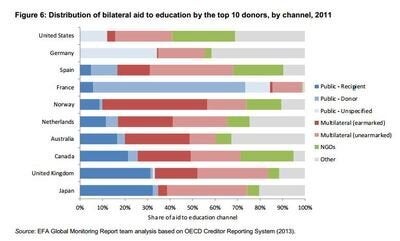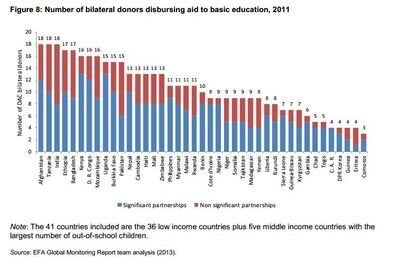Aid has played a key role in supporting the Education for All goals. But now that support is in danger of being undermined as donors distribute aid through non-government channels, fail to coordinate their efforts sufficiently, or turn away from education altogether. As education partners gather to debate the post-2015 agenda, new analysis of aid trends by the EFA Global Monitoring Report team underlines the need for a post-2015 financing goal - and a fresh commitment to education aid.
Since the EFA goals were established, aid from donors belonging to the OECD's Development Assistance Committee Aid (DAC) has been indispensable in boosting progress towards the goals. Nevertheless, they have failed to keep the promise they made in 2000 that no country would be prevented from achieving Education for All by a lack of resources. This failure, which is one reason the goals have largely not been met, is now being compounded by changes in aid priorities that threaten education progress.
As representatives from Western Europe and North America meet in Paris on December 5-6 for a regional consultation met on education after 2015, co-hosted by UNESCO and UNICEF, the EFA Global Monitoring Report team released a paper on aid trends. Our analysis shows that a post-2015 goal on education financing is crucial to make sure donors not only stick to their promises in future, but also renew their commitments to providing aid in a coordinated way that supports recipient governments.
Although aid to education has risen over the past decade, there are signs of reversal since 2010. Low income countries, which account for 37% of out-of-school children, have been hardest hit, facing a reduction of 9%. This is a worrying trend: while domestic funding is the most important source of funding for basic education, aid plays a particularly vital role in the poorest countries.
It is not just the amount spent by donors that matters, but also how these resources are allocated. The EFA movement, through the Dakar Framework for Action, encourages country-led education planning: for aid to be effective, donors need to channel their funds via government systems wherever possible. Unfortunately, our analysis shows that DAC member countries reduced the share of aid they channelled via the public sector from 42% in 2008 and to 36% in 2011.
This figure for funding through the public sector masks the amount actually reaching recipient countries. Some donor countries channel a significant part of their funds through their own government agencies, some of which is likely to be for spending on students studying in donor countries. For instance, only 7% of the aid France disburses through the public sector is under direct control of recipient governments.
Some donors - including Canada, Spain and the United States - also channel a large share of their funds through non-government organizations. While this can be a means to reach marginalized children, it is unlikely to strengthen government education systems in the long term.
Aid that contributes directly to government budgets - known as general budgetary support - has become recognized over the past decade as an approach that enables governments to prioritise how to spend the funds to implement their education programmes. Yet, as a share of total bilateral aid, such support has fallen from 4.8% in 2003, to 3.5% in 2009 and 2% in 2011, suggesting a move back towards project-based aid that enables donors to attribute change to their own programmes.

DAC donors are also increasingly channelling their funds via multilateral agencies, particularly in ways that allow multilateral agencies make decisions about how to spend the funds (including whether on education or other sectors, and which countries to focus on). Channelling of funds in this way increased from 21% in 2008 to 27% in 2011. This is likely to indicate that bilateral donors are lowering the priority they give to education, and hence their commitment to managing their education aid directly. In some cases, funding is earmarked for the Global Partnership for Education (GPE), but GPE's funding has been lower than expected, constituting a small share of aid compared with the contribution that global funds make to health, for instance.
Strong global coordination by donors to education is vital given that the sector has a very narrow donor base. In 2011, for instance, the top 10 donors provided almost three-quarters of overall aid to education, and just three donors provided close to one-third of aid to basic education. While numerous coordination mechanisms exist, donor agencies do not seem to be using them when deciding where to work and - crucially - how to reach children most in need.
In Afghanistan, Bangladesh, the Democratic Republic of the Congo, Ethiopia, India, Kenya and the United Republic of Tanzania, at least 16 bilateral DAC donors are active, while the Central African Republic, Chad, Eriteria and Guinea only have no more than five. In all those countries with at least 16 bilateral donors present, at least one-third of their aid partnerships are classified as non-significant, suggesting that aid in these countries is not being spent effectively, and could be better allocated elsewhere.

Poor coordination leaves some countries with insufficient resources for education. While our calculations show that it costs around US$130 per primary school age child to provide education of acceptable quality, low income countries allocate US$41 per primary school child from their own budgets, and receive US$16 per child from aid donors, with great disparities among countries. For instance, while aid to basic education in 2011 was US$39 per child in Afghanistan, it was only US$4 in Chad, which has some of the poorest education indicators in the world.
Despite growing interest in non-DAC donors and the private sector, their education funding remains extremely small compared with aid from DAC donors, which therefore must continue if poor countries are to achieve education goals after 2015. Proposals that funding gaps can and should be filled by others are not realistic: rather, recent moves to reduce aid and support for government systems urgently need reversing. That is why the EFA Global Monitoring Report is calling for the post-2015 education goals to include specific targets for financing by aid donors, within a broader aid effectiveness agenda. Otherwise, disadvantaged children from the poorest countries will continue to be left behind.
